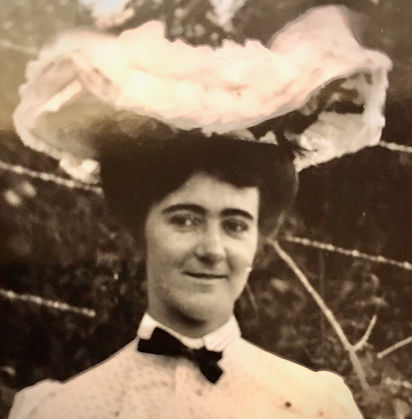MORE
_HISTORY
[
Our member John Clowes has a fascinating historic connection going back over 100 years and events which might have been the precursor to his considerable interest in photography and joining PPP.
]

GEORGE MOORE


AUNT MAUDE
These photographs originate from glass plate negatives taken around 1910-15 by George Moore, John’s maternal grandfather.
IRENE MOORE
Story By
John Clowes_
George Moore was born at Inverell in 1877. As a young man he competed in bicycle races and I still possess his winning medals from 1899. He married my grandmother Ethel nee Whitehair and they settled in Redfern. George was an accountant eventually becoming Chief accountant for the Wunderlich tile company. In Sydney he continued his interest in sport both cycling and rowing.
His rowing skull was stored at George Towns shed opposite Sydney Rowing Club. In addition to his sporting interest he also took up photography and evidently used the bathroom in Redfern as a makeshift darkroom. His topics included major events in the city of Sydney, family members in various poses and excursions to the Royal National Park.
He was a keen traveller both in regional Australia and overseas to Europe. He died and was buried at sea on the way home from a European tour. Many years later I discovered boxes of his glass plate negatives in a cupboard in Roseville, his last home. My uncle told me that when the family moved to Roseville Ethel refused to let him turn the new bathroom into a darkroom and so his hobby was sadly terminated.
I have made various attempts to process some of the glass plates and hope to do more at PPP in the wonderful new darkroom facility. The slight frustration is that the plates are nameless so it is difficult to work out the who, when and where! The few that I have put a name to include my mother Irene as a child and her aunt Maude who sadly died of the Spanish flu.
I am hoping that thanks to Primrose Park Photography I will be able to bring to life some of George’s work and images of my family and share this experience with all the members.
John Clowes


JOHN AND MUM
AUNT MAUDE
More
PPP
History_
Historical items and sites including Aboriginal rock art indicate that Primrose Park was frequented by the Cammeraygal people.

The Cammeraygal were a clan of the Eora tribe of Indigenous Australians who were united by a common language, strong ties of kinship and survived as skilled hunter–fisher–gatherers in family groups or clans that inhabited the Lower North Shore of Sydney. They occupied discrete territories within which there were various camp sites – each used for a limited time depending upon the season, the availability of food or the activity undertaken, such as tool manufacture. There does not seem to have been defined villages or permanent camp sites within these territories.

The traditional lands of the Cammeraygal people are now contained within the North Sydney, Willoughby and Mosman area. The Cammeraygal people lived in the area until the 1820s and are recorded as being in the northern parts of the Sydney region for approximately 5,800 years.
The name Cammeraygal is ensigned on the North Sydney Municipal emblem. The North Sydney suburb of Cammeray and the Cammeraygal High School located in the North Sydney suburb of Crows Nest are named after the Cammeraygal people. In 1999, the North Sydney Council erected a monument in honour of the Cammeraygal tribe who are the traditional owners of the North Sydney area.
Primrose Park - Neutral Bay, derives its name from colonial times. During the colonial times, there were various bays in Sydney that supported the docking of foreign vessels. The term Neutral Bay is in reference to the neutral docking of all foreign vessels. 1789 is when the name was originally indoctrinated. The Governor of Sydney, Arthur Phillip, named this common docking bay as "Neutral Harbour". All foreign ships were encouraged and invited to dock here while resupplying their ships with food and water. Around 1899, the land became the first site in Sydney for the sewage treatment works, closing shortly after in 1920. The area was dedicated in 1930 to the park it is now. The park got its name from HL Primrose, who was the North Sydney Mayor from the period of 1926 to 1932 and later NSW Minister for Health.


